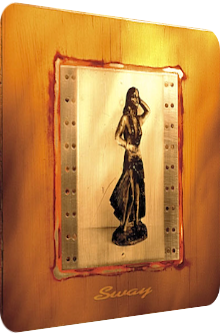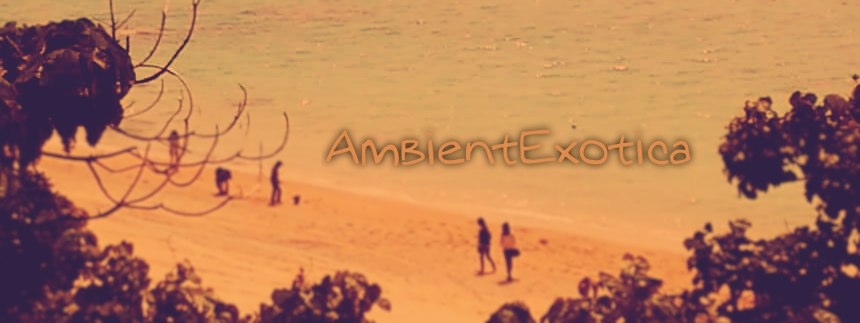
The Blue Hawaiians
Sway
1998
In 1998, The Blue Hawaiians deliver their first studio album after years of performing at the Lava Lounge in Hollywood. The energy of a typical night was heretofore gathered in the Rockabilly-heavy Live At The Lava Lounge, released in 1995 on Pascal Records. Their studio album Sway, also released on Pascal, builds on the energy of their live performances, but comprises of important changes.
Firstly did the band setup change: Gary Brandin takes over the role of former steel guitarist Bron Tieman, while everyone else remains on board, namely vocalist and bassist Mark Fontana, drummer and Ambient musician maxwellvision, lead guitarist Mark Sproull and keyboardist/organist Michael Murphy. Secondly do the five musicians come up with shedloads of unique compositions, whereas their material of their Lava Lounge gigs consisted largely of renditions and interpretations of various Shoegaze and Surf Rock classics. Thirdly do The Blue Hawaiians purposefully reduce the bile and acid in their own tracks. This doesn't mean that the 15 offered tunes are streamlined and whitewashed ditties, but a boost in dreaminess and brightness is strongly noticeable. And finally does the delivered material comprise of mostly instrumentals, with only three vocal tracks scattered in-between. Keeping all these changes in mind, Sway is nonetheless a successful continuation of the band's style overall, as there are many harsher undertones included. An in-your-face attitude is still apparent, and many of the tracks sound like inventive, high energy jam sessions. Below is an in-depth review of all 15 tracks, and while there are a few duds on this release, the overwhelming majority either rocks the hut or lets you dream.
The album launches with one of the best openers in the history of Surf Rock, mark my words and start your engines, for maxwellvision''s composition Last Days Of Summer shimmers and glows due to the permanent shifts between nostalgia and bubbling joy throughout its runtime of three minutes. The powerful drums of maxwellvision lead into Gary Brandin's cozily wafting steel guitar dreaminess, Mark Fontana's belly-massaging bass twangs and Mark Sproull's alternating eight-note motif on the electric guitar. The quavering tremolo of Michael Murphy's organs may be liminal, but it undoubtedly backs the positive vibe of this surf hymn successfully. The catchy riffs and good mood of this tune are absolutely stunning, and I consider it to be the band's signature tune. It's not overly eclectic, as The Blue Hawaiians don't want to waste the synergy of their true talents right from the get-go, but it's the pinnacle of a lifestyle near the beach, with lush palm trees and sunny temperature levels. The omnipresent danger of colder seasons is well-interwoven and depicted in the few notes in minor, but the golden aura of Last Days Of Summer outweighs the doleful moments. An essential tune!
The following Searchin' For Da Cat is written by Fontana and adds a savage attitude to a nocturnal tune, with gorgeous drum patterns, warped licks of the steel guitar whose sustain is elevated in typical Hawaiian fashion. Sizzling-hot Hammond B3 bursts augment the nightly scenery, as the main melody on the electric guitar harks back to the band's performed material at the Lava Lounge; it's the sleazy kind of Dark Exotica, evoking a multitude of shades and the repetitive landscapes on California's lonesome roads. Banzai Pipeline is a wild rendition of Henry Mancini's Lounge classic, which has never been heard in this way before. Rapid firing drums, organ stabs and acidic guitar pulses accompany Sproull's sun-soaked lead guitar that twinkles in all colors, from a cool blue attitude to emerald-green lushness. Mancini's tune is almost unrecognizable and played way too fast in order to maintain its former Cocktail Lounge spirit, but what the heck, this ride is wild and leads into the mellow soundscapes of Casino, a song written by Bron Tieman, the former steel guitarist of The Blue Hawaiians. Featuring Japanese vocals of chantress Karu Mansour, the band broadens the formula with Far Eastern scents in an otherwise steel guitar-fueled, acoustic guitar-infused Hawaiian island-depicting saccharine reverie in technicolor, where available.
A desperado's bile is brought back with maxwellvision's Deadman's, a mysteriously sunset-colored Steppe full of abyssal bass lines, the dusty catchiness of Hammond organs and dangerously cool outlaw riffs on the electric guitar. This song is all about freedom, and while many sections seem to be improvised or result from jam sessions, they are actually great counterparts to the majority of the featured material, for the interdependence of sound, sustain and space can be worshipped all the better if the rough skeleton of the track – the bass guitar – is the actual golden thread (or threat?), with all the remaining instrumentals fading in and out at will.
While the following Quiet Surf by Richie Podolor meshes the coolness attitude of Deadman's with a majestic depiction of a surfer's life full of quickly beaten drums, spectral steel guitar gusts, organ accents and short eruptions of polyphonous strings, Hugh Morten's following theme of Hawaii Five-0 is presented in an utterly dreamy version called Martini Five-0. It's solemn, extremely balmy and lush, keeping the famous theme intact, but enriching it with steel guitar sweeps, electric guitar washes and 60's organs. It's a hugely successful version, considering that The Blue Hawaiians could have made their lives so much easier by simply revving the tempo of this spy theme up even more. But no, the opposite is the case, and the formerly swinging excitement is transformed into a cherubic mirage. Gargantuan!
Mark Fontana's Swingin' Hula Girl starts with radio frequencies and static noise and lead to the first male vocal track, as Fontana himself sings about the enchantment of a hula girl, but instead of making this a dreamy ballad, it's a Shoegaze song with interspersed xylophones, soft maracas, short sections of castanets and various phantasmagoric steel guitar sparkles by Gary Brandin. Shuttling between melancholia and nostalgia, this is not the bright bonmot the stereotypical track title suggests, but it stays true to the band's Lounge roots.
Drop The Hammer, Max! presents an intriguing mixture of dark guitar strings and Michael Murphy's coruscating organ droplets which are the actual stars for me, at least until maxwellvision drops a pumping drum solo that increases the pressure in a tasteful way. Otherwise, this song is a bit of a letdown as the melodies aren't that strong and remain curiously scattered. On the plus side, this composition is all about the textures and characteristic traits of the instruments, and listening to this song from this angle, it is similar to Deadman's in that it inherits the creativity of a jam session.
Up next is Sharkskin Saddle, and this rodeo song by Mark Sproull consists of much better carved out melodies, evoking danger and synesthetic redness in the lead guitar, injecting a whirring thermal heat in the organ accompaniment and delivering a surprising tempo shift to slower regions. Another Henry Mancini interpretation follows, and this time it's Charade which was co-written with Johnny Mercer. As expected does the band deliver the unexpected, exchanging the brass sections with liquedous steel guitars, but keeping the vocals of this world-famous classic intact. It's a glaringly sad composition and somehow breaks the intrinsic-endemic style of the band. It's too thin and bland for my taste, but that's my sole problem, as there isn't anything wrong instrumental-wise. Since the band is even able to sneak in a few backing tone sequences of the James Bond Theme and gets away with it, you got to acknowledge the guts in the end.
While Mark Fontana's Tortolla seems to keep the gloomy mood up with an acoustic guitar solo that luckily morphs into a hefty steel guitar-framed theme of freedom that's loaded with staccato drums, scintillating ghost-like organ layers and the known motif of independence on the electric guitar, Drunk Man Noodle plinks along in Asian style and boosts the danger thanks to a four-note bass guitar theme, with cacophonous and baneful guitar eruptions being thrown at the listener which spiral upwards and increase the tension. It doesn't get any darker and more tense than this, as the band's most pressuring track rolls forcefully over the listener. As it happens so often on Sway, the melody on the bass guitar is the only hummable source. The penultimate composition is a reprise of track 2, Da Cat. It slows the tempo down, gets rid of the cymbals but adds glacial guitars and gently beaten bongos to the mix. It's not a mere reprise, but a mighty dreamy retake.
The final Element 86 is without a doubt the most curious arrangement die-hard Exotica fans might encounter in a long while. After two minutes of silence, this 5+ minutes long collage comprises of various warbled licks, fata morgana-esque guitar breezes, theremin-like spectres, Space-Age laser sounds and mosquitoing buzzes. Melodies? Nil. The only earthen element are the brazen cymbals that clang and clash occasionally. It's a noteworthy example of an Ambient Exotica track and a curious, if strongly exciting closing track.
Sway by The Blue Hawaiians is a hybrid of syrupy Pop riffs and delicately pernicious desperado twangs. Oscillating between the dreamy and the baneful sides of Surf Rock attitudes, the band manages to preserve the shadowy flavor of their live performances at the Lava Lounge and embeds it tightly in the majority of the presented material. Whatever the band comes up with, whether it's their dark compositions, their open-minded takes on classic Exotica and Cocktail Lounge material or aural experiments of the third kind as delivered in the outro, the studio debut album foams over with ideas and melodies, the latter of which aren't always catchy or carved out, but this is deliberately done in order to inherit a certain feeling of improvisation and jam session frenzy. That the band is able to pile pompous sugar hills is immediately shown right at the beginning with the opener Sway. It's easygoing and not overly complex, true, but this helps the catchiness very much. I consider it the strongest track, but their dreamy material is noteworthy time and again as well. Never will you hear a balmier version of the iconic Hawaii Five-0 Theme than on this album!
Since both quality and quantity are congruently attached, there isn't any good reason to ignore this gemstone. One word of warning which I've already mentioned in the first paragraph: only three out of 15 tracks feature vocals, a huge change in comparison to the live album. This might disappoint many Shoegaze and Rockabilly fans, but isn't that big a problem at the end of the day, for the instrumental interplay is so utterly enchanting. Sway is a wonderful guitar-driven album that can be rightfully linked to the Exotica genre due to the steel guitar mellowness and Hawaiian tonality.
Exotica Review 128: The Blue Hawaiians – Sway (1998). Originally published on Sep. 29, 2012 at AmbientExotica.com.
